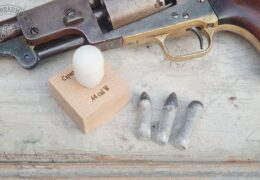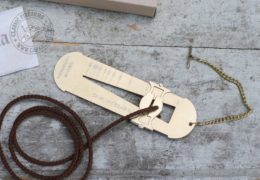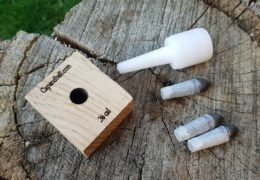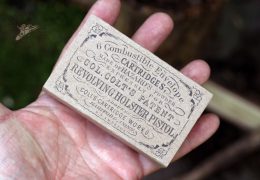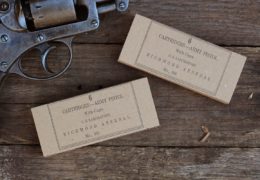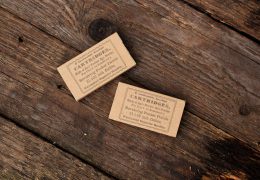The Swiss Feldstutzer – Part 2: recreating the Model 1851 cartridge
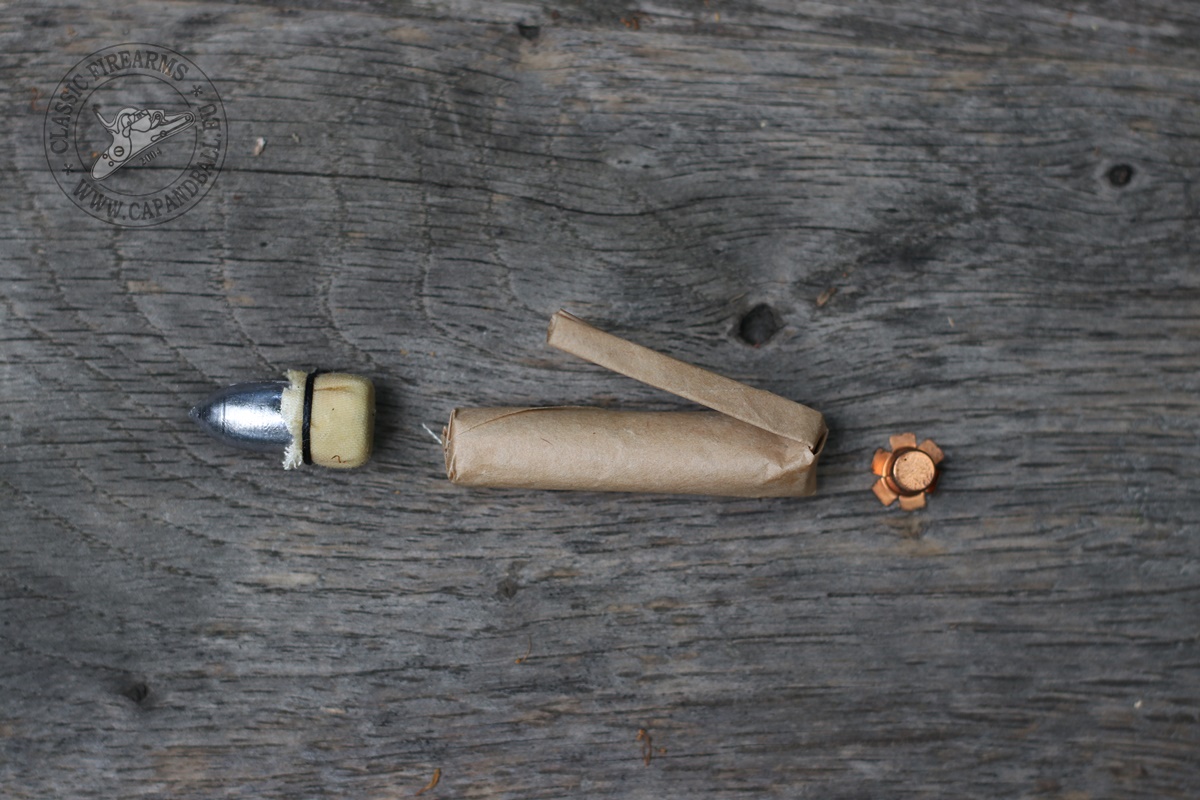
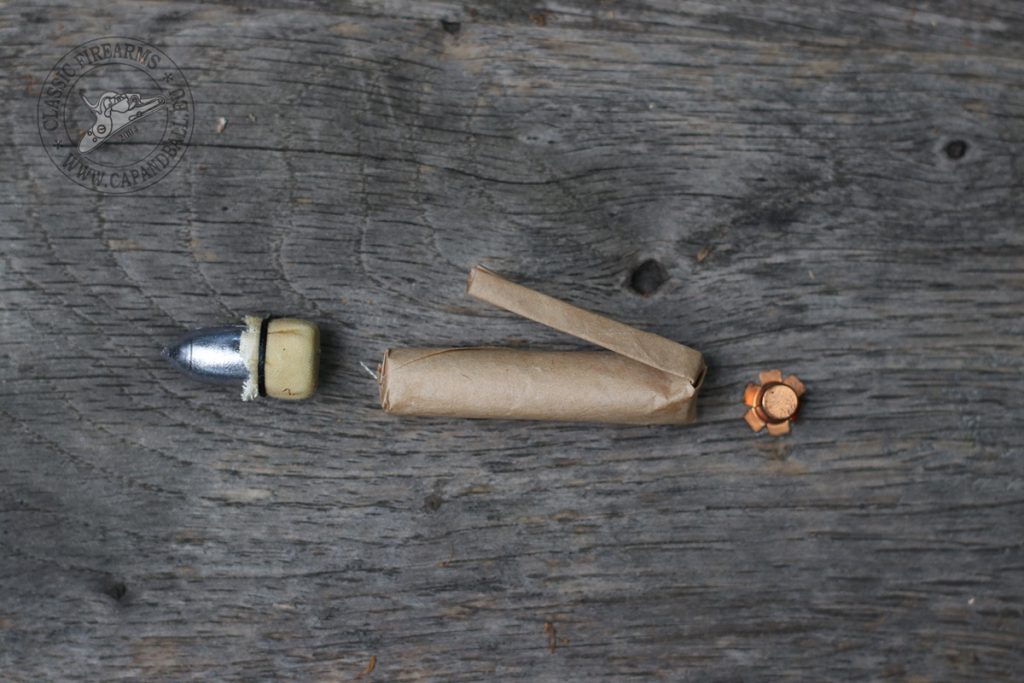
Model 1851 cartridge ready for shooting
The purpose of this chapter is to show you the background work behind a historical shooting session. The procedure you see is the one I usually use when I am recreating cartridges for the Capandball YouTube videos. But now let’s start with some additions to Part 1 of the series.
Additions to the previous chapter about bullet weight and velocity
Lighter bullet and lighter cartridge also had an advantage regarding the weight the soldier had to carry. A brief comparison of different service cartridges of the era gives a clear picture about the benefits of having a lighter round in the cartouche:
| Firearm | Weight of 1 cartridge | Weight of 60 cartridges |
| Swiss Model 1842 cartridge (17 mm cal.) | 33 g | 1980 g |
| Swiss Model 1859 cartridge (17 mm cal.) | 42 g | 2520 g |
| Swiss Model 1851 cartridge (10,5 mm cal.)[1] | 21 g | 1260 g |
| Swiss Model 1856 cartridge (10,5 mm cal.) | 21 g | 1260 g |
| Swiss Model 1863 cartridge (10,5 mm cal.)[2] | 23.5 g | 1410 g |
| French Minié cartridge[3] | 51,5 g | 3030 g |
| U.S. Model 1855 cartridge (.58” cal.) [4] | 37,3g | 2178 g |
| Austrian Model 1854 cartridge (13,9 mm cal.) [5] | 33 g | 1920 g |
| Austrian Model 1842 cartridge (17,5 mm cal.) [6] | 36 g | 2100 g |
Just by looking at the numbers we can easily understand the advantage, but let’s not forget that not only cartridges were placed in the cartouche of the Swiss sharpshooter. He had also 1 kg of lead and the bullet mould in the cartridge box so the weight he carried was nearly the same a French soldier had to carry. So even if the cartridge was lighter the Swiss soldier did not have a larger ammo allowance than any other soldier of the era and nor he carried less weight.
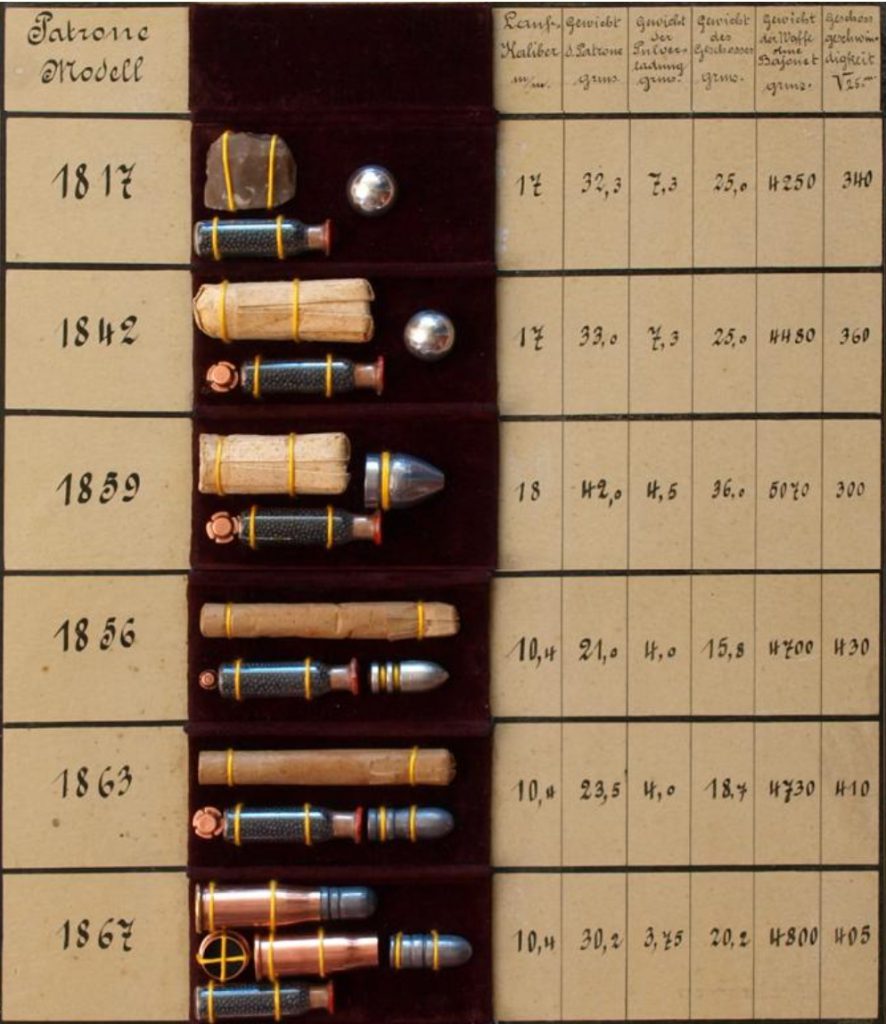
Cartridges from the Rubin cartridge collection with valuable data. Sorce of the picture: https://www.armeemuseum.ch/wp-content/uploads/2015/05/Sammlung-Rubin.pdf
High muzzle velocity has also an advantage when it comes to shooting at moving targets. The faster the bullet is the shorter the flight time is. Engaging moving targets needs pulling the point of aim ahead of the target to a certain distance. The higher the muzzle velocity is the shorter this distance will be, therefore the easier the aiming is. Let’s check a simple practical example for this. Let’s suppose that we have a soldier armed with an Austrian Model 1854 “Lorenz” inafantry rifle and another soldier with a Swiss Model 1851 Feldstutzer rifle. The enemy is moving in 90 degrees at a distance of 1000 paces (750 meters) with 5 km/h speed. The bullet fired from a Feldstutzer rifle needs 2.7 seconds[7] of flight time to reach the target. During this time the enemy soldier moves 3.75 m so the Swiss soldier has to move the point of aim 3.75 m ahead of the target. The 51 g heavy bullet of the French Model 1846 Carabine a Tiége rifle issued to the Zouave and Chasseur troops needed 4.37 seconds of flight time to reach 809 m distance.[8] In the same situation the enemy soldier will move 6 meters, therefore the point of aim must be placed 6 meters ahead of the target. The larger this distance is, the harder the proper aiming will be.
Recreating the Model 1851 Cartridge
It is a good question why we have to shoot these old rifles again while we have so much detail about their performance from contemporary sources. I have 3 simple answers for this question: First because the historical data can be inaccurate. This is especially true when the writer is in somehow a dependent status, for example he is an officer of the army whose rifle was tested. Each and every nation highlighted the benefits of their own rifles while hiding their flaws. Second there are aspects of the performance of the rifle that could not be documented accurately in the 19th century. This is especially true for terminal ballistics. Third I shoot these rifles because historical target shooting is a tremendous fun.
There are four important aspects of the cartridge we have to recreate accurately. First task is to find the right bullet. In this case the solution was obvious as I managed to purchase an original Wurstemberger style bullet mould that once was probably part of the personal gear of a Swiss sharpshooter. The mould is preserved in perfect condition, no corrosion damaged the cavity. The bullets drop from the mould at 10.40-10.51 mm diameter cast from pure lead.
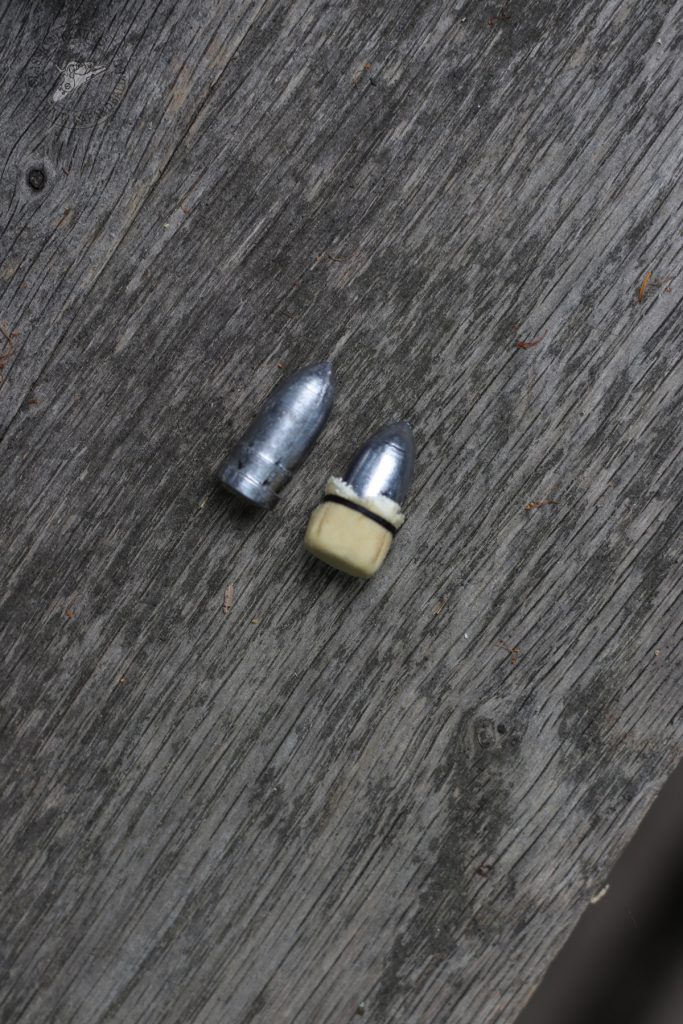
Model 1851 bullet ready to fire
The weight of the projectile is 16.61-16.86 g proving that it perfectly fits our historical test shooting project. The cotton material I used for the patching measured 0.38 mm in thickness. I tied the patches to the bullets with a string as it was done originally, and melted the mix of lard and tallow in a mug. I dipped the bullets into the molten lube to entirely saturate the patches. Finding the closest equivalent of the No. 4. powder in this case was not a hard task as there is still a black powder mill operating in Switzerland[9] making the same black powder as in the 19th century. Even their product names refer to the black powder granulations of the past centuries. The modern made Swiss No. 5. shooting powder is matching completely our needs regarding the grain sizes. Granulation of modern and old powders:[10]
| Granulation | Modern Swiss Shooting black powder[11] | Old Swiss black powder[12] |
| No. 1. | 0.250-0.500 mm | 0.600 mm |
| No. 2. | 0.500-0.800 mm | 0.900 mm |
| No. 3. | 0.650-1.200 mm | 1.200 mm |
| No. 4. | 0.850-1.200 mm | 1.500 mm |
| No. 5 | 0.1200-1.600 mm | 1.800 mm |
Although the pressure of the gases generated by the burning powder could be calculated the strength of the powder was tested on various instruments capable of measuring the force of a specific volume of black powder. The results were compared to each other and quality ranges were specified for different type of firearms. Powders were manufactured in state owned and private powder mills therefore an effective system was necessary to check the quality before acceptance. If the strength of the powder varied in the cartridges the possibility to set the sights properly was lost immediately.
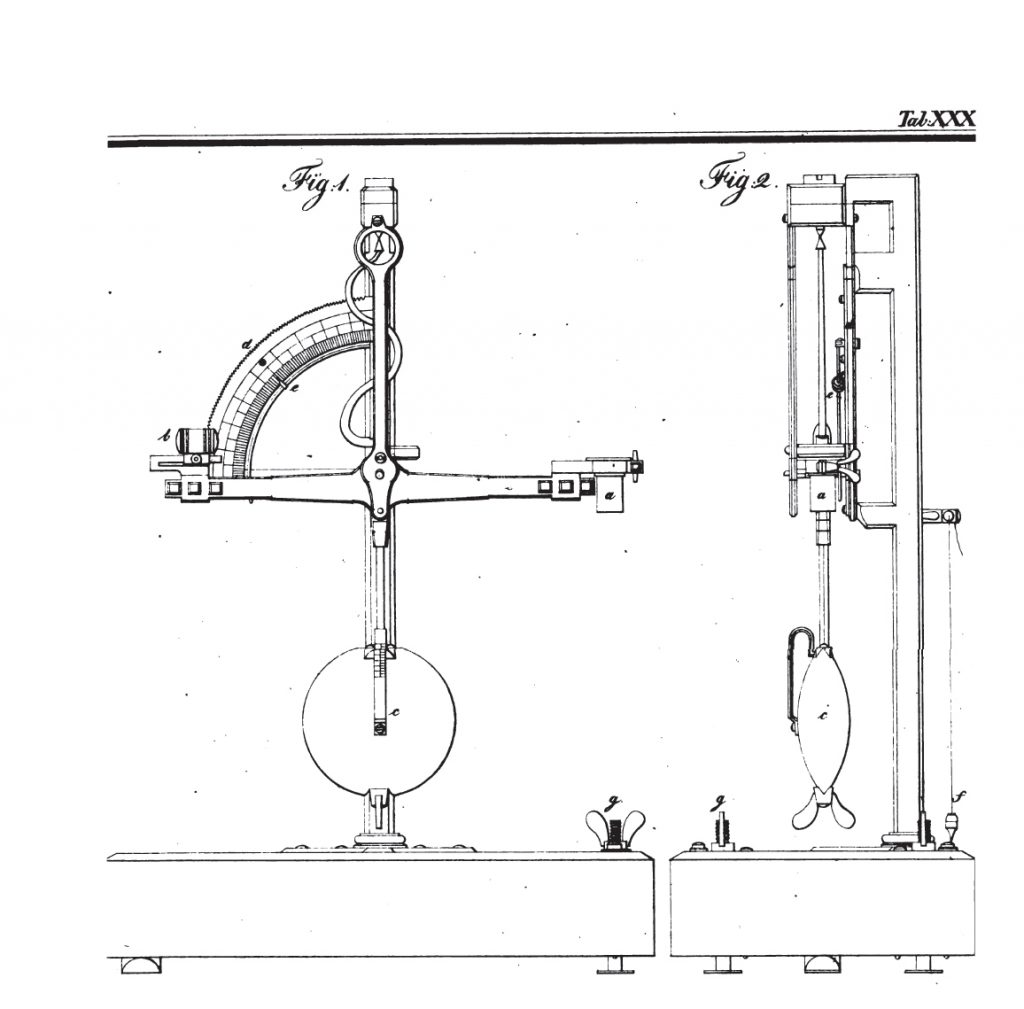
Pendulum for measuring the strength of black powder
Such instrument – the pendulum powder probe – is described by Beroaldo Binachini as a machine with two arms. On one arm a small powder chamber is attached on the other a weight is hinged. Hanging from the center axis is a heavy watch pendulum. The small powder chamber is always loaded fully with powder. When the charge is ignited the gases force the arm with the chamber move downward against the weight of the pendulum, while the other arm elevates and stops on the scale showing the “gradirung” of the powder.[13]
Range tests the Model 1851 Feldstutzer with the Model 1851 cartridge
Shooting a historical firearm always needs a good amount of responsibility. First of all we must never forget that we are dealing with an unrepeatable artefact of the past. Second all firearm related activities need care and attention and each parts of the historical shooting project must be in compliance with applicable laws. One important aspect of the preparation period if the complete examination of the firearms. This examination must ensure safety and must ensure that each components of the firearm are meeting the original specifications so the results of the test will be reliable. The organisation entitled to commence such examination In Hungary is the official CIP[14] proof house.[15]
At this stage of the project my only goal was to recreate the external ballistics of the Model 1851 service charge to verify the sources about trajectory and accuracy and to create a subjective evaluation about the use of the rifle. Accuracy, muzzle velocity, energy, tendency to malfunction, weight, balance are objective measures but to evaluate the handling of the rifle the researcher must include subjective factors as well that can have an effect on tactical performance. These factors include the ease of loading, overall handling of the rifle, comfort of the stock, clearness of the sight picture, complexity of maintenance. My aim is not to evaluate the combat use of the rifle still these subjective factors can have an impact on the results of the laboratory tests as well. One simple example to support this point: the ease of loading has an effect on external ballistics as if ramming the bullet in place needs severe force the point of the bullet can be damaged during the process that will result loss of accuracy.
Setting the powder charge
The closest equivalent I had access to substitute the original powder was the Swiss No. 5. black powder. The first step of the shooting project is to set the weight of the charge to match the originally documented muzzle velocity. The contemporary sources indicate muzzle velocities around 440. Usually it takes a long time to build up a load to arrive to the original data but this was not the case with the Feldstutzer. I measured 4.00 g by weight with an accuracy of 0.01 g.[16] I fired 6 shots with the same charge through a gun chronograph to measure the bullet velocity. As the first shot is fired from a clean bore we can expect that the muzzle velocity will be different,[17] therefore it must be excluded from the statistics.
| 4.00 g No. 5. | Velocity |
| 1st | 443 m/s |
| 2nd | 445 m/s |
| 3rd | 437 m/s |
| 4th | 440 m/s |
| 5th | 433 m/s |
| Average | 439.6 m/s |
| Deviation | 10 m/s |
The first shot from the clean bore measured 383 m/s proving that constant gas pressure can only be obtained when the bore is already fouled. The average of the 5 consecutive shots to count (439.6 m/s) proves that the selected charge is an authentic reproduction of the original load. The deviation of velocities (10 m/s) is not significant, in fact it can be considered excellent for a muzzle loading rifle. The Wild disc n the ramrod ensures that the bullet is pushed to the same depth and it also ensures that the powder charge behind the ball is not crushed. These are important aspects of reaching constant gas pressure.
The procedure of loading
The loading procedure starts with cocking the hammer. The Feldstutzer does not have a half cock safety so the hammer is set to the full cock firing position immediately. The paper cartridge is then drawn from the cartouche, the end of the paper case is bitten off and the powder is poured into the bore. Now the patched bullet is inserted into the muzzle and the ramrod is drawn from the channel in the stock. The ramrod has a cavity in the end matching the shape of to the bullet so it will not deform the point of the projectile while loading. Pushing down the bullet needs significant force and time. I have experience in loading and shooting the most important muzzle loading military rifles of the era. I shot the U.S. Springfield, the British Enfield, the Austrian Lorenz, the French Minié rifles and rifle muskets with cartridges made according to original specifications but none of these rifles was as hard to load as the Feldstutzer with the Model 1851 cartridge. The paper cased cartridges of all the mentioned rifles are quite easy to load. The bullets – even if they are paper patches – go down the bore with a very little force or just by the weight of the ramrod. Loading Model 1851 Fedstutzer bullet is much harder: needs more physical effort from the shooter and consumes time. I am able to load any of the rifles mentioned in 20-30 seconds while loading the Feldstutzer needed 50-70 seconds. Rate of fire suffered severely because of the “forcing principle”.
Aiming, sight picture, handling of the rifle
These are all subjective aspects of using a firearm therefore this section cannot be considered essential part of this historical shooting project. On the other hand the writer of this study has been shooting historical military firearms for more than 20 years competing on international levels with such arms therefore probably his experiences can also add a few bits to the great picture.
First of all the Feldstutzer is one of the most comfortable military rifles I have ever shot. Being the close descendant of the offhand target shooting rifles of the era they are ergonomic and well balanced. The secure hold is supported by the heavy butt stock and the Germanic “Schützen” type butt plate and trigger guard. None of the contemporary military rifles were designed on the target shooting principle.
The rear sight’s distance from the eye of the shooter is a key factor in clear sight picture. The further the sight is the sharper sight picture the shooter has. This is especially true for middle aged and older people. Here are some measurements from contemporary rifles:[18]
| Rifle | Sight distance from the end of stock |
| Austrian Model 1854 “Lorenz” rifle | 51,5 cm |
| Austrian Model 1854 “Lorenz” Jägerstützen | 52,5 cm |
| British P56 “Enfield” rifle | 64 cm |
| U.S. Model 1863 “Springfield” rifle musket | 47,5 cm |
| French Model 1859 “Minié” rifle | 51 cm |
| Swiss Model 1851 Feldstutzer | 51 cm |
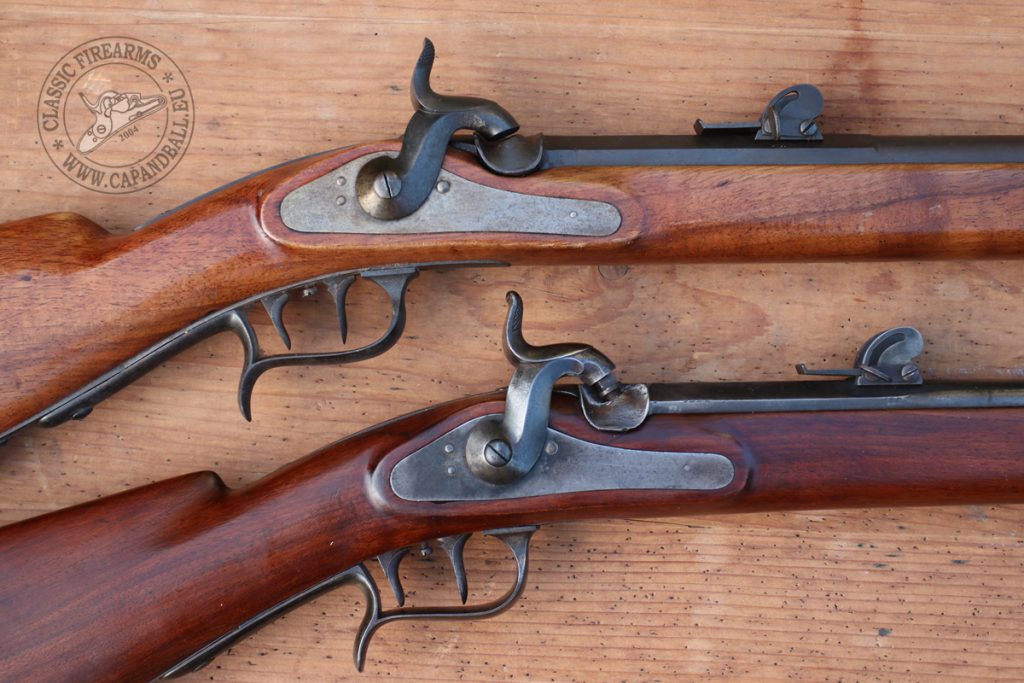
The distance of the rear sight from the shooter’s eye is not better than on most of the military rifles of the era
The long range sight of the Feldstutzer is surely one of the most advanced sights of the mid 19th century. It can be set to the specific distance easily and quickly while it can also be adjusted horizontally as it is fixed on the bore with a dovetail. However the sight picture itself is not better than any of the rifles mentioned in my comparison. The only positive example from this conglomeration is the British P56 Enfield rifle.
Recoil
Recoil is an objective measure still important today in firearms development. Recoil has a direct impact on accuracy. First it moves the bore while the bullet is still in the barrel. Second if the recoil is too hard the shooter will fear the shot and the shot itself will tire the nerves of the soldier. Manageable recoil therefore has always been an important factor in firearms development. The lighter the recoil is the more accurate the shot will be.
| Firearm | Recoil |
| Austrian Model 1854 “Lorenz” infantry rifle[19] with Lorenz type compression bullet | 50 Wiener Pfund[20] / 28 kg |
| French “Minié” infantry rifle with Minié style skirted bullet[21] | 66 Wiener Pfund / 36,96 kg |
| Belgian Infantry rifle with “Charin” type[22] paper patched skirted bullet[23] | 62,5 Wiener Pfund / 36,5 kg |
| Smooth bore infantry rifle with round ball projectile[24] | 63 Wiener Pfund / 35,28 kg |
| Swiss Model 1851 Feldstutzer | 31,5 Wiener Pfund / 17,64 kg[25] |
Recoil is an exact value in laboratory circumstances but it is a perception while shooting a specific rifle. The felt recoil is depending on many factors. Most important are the ergonomics of the stock, weight of the rifle and the size of the butt plate. Even if the exact values show that the recoil of the rifle was significantly lighter I was not able to make a differentiation against a Minié or Lorenz rifle. The smooth bore infantry musket is an exception as these firearms have a tremendous kick due to the excessive powder charge weighing minimum the double that of the military rifles.
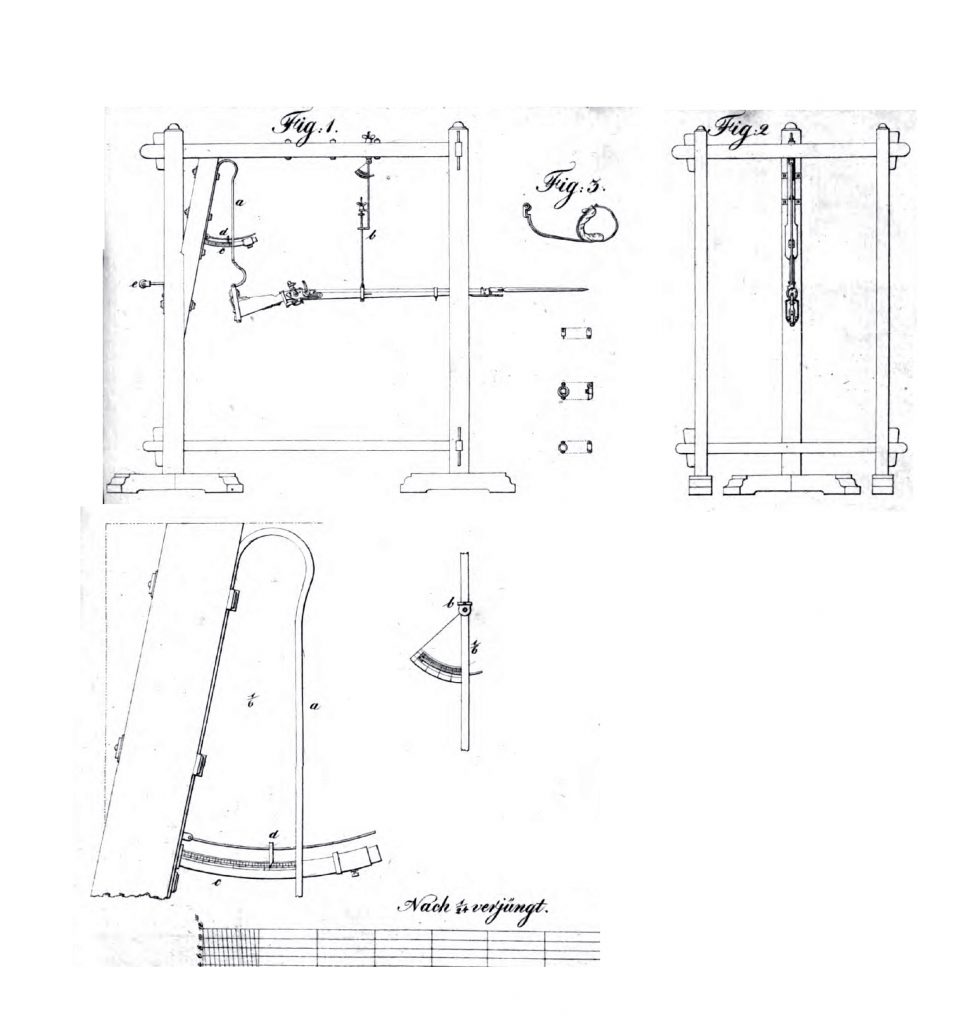
Machine for measuring recoil (Arsenal in Vienna, Bianchini)
Recoil was measured on specific instruments. The first 4 data came from an original document from the Kriegsarchive in Wien while the Feldstutzer’s recoil is a data related to one of the values extracted from this paper therefore it is advisable to know the instrument used by the Austrian Army to determinate the kick of the firearm. The machine designed to measure the force of the recoil consisted of a wooden stand holding a spring with a scale and an arm to hang the gun on it. Upon firing the recoil pushed back the gun against the spring. An indicator stopped on the scale at the mean deviation marking the exact value. It was a simple and ingenious machine to compare different arms.[26]
Balázs Németh, 2018.
Part 1: The Model 1851 Feldstutzer and its impact on rifle development – Part 1
Part 2.: The Swiss Feldstutzer – Part 2: recreating the Model 1851 cartridge
Part 3: The M 1856 and M 1863 cartridges and range tests of the Feldstutzer
Part 4: Shooting the Feldstutzer to 100-300 meters
Part 5: Terminal ballistics of the Buholzer cartridge
Resources
Books, studies, articles:
Allgemeine deutsche Militair- und Marine-Beitung (DMMB)
Anonymous: Das Deutsche Wehr- und Schützenwesen. Darmstadt, Leipzig, 1862.
Antoine de Henri Jomini: The Art of War. Philadelphia, 1862.
Beroaldo-Bianchini, Natale: Abhandlung über die Feuer- und Seitengewehre, worin die Erzeugung, der Zweck und der Gebrauch aller einzelnen Bestandtheile, dann aller Gattungen kleiner und Jagdgewehre, mit der Angabe und… Wien, 1829.
C. v. H.: Schiesspulver und Feuerwaffen. Leipzig, 1866.
Caesar Rüstow: Das Minié-Gewehr. Berlin, 1855.
Caesar Rüstow: Die neueren gezogenen Infanteriegewehre. Darmstadt, Leipzig, 1862.
Cadmus Marcellus Wilcox: Rifles and Rifle Practice: An Elementary Treatise Upon the Theory of Rifle. New York, 1859.
Dr. Reinhold Günther: Allgemeine Geschichte der Handfeuerwaffen. Leipzig, 1909.
Ernst Hostettler: Hand- und Faustfeuerwaffen der Schweizer Armee von 1842 bis heute. Zürich, 1987.
Friedrich Engels: The history of the rifle. in: Engels as a military critic. University of Manchester, 1952.
Friedrich Müller: Waffenlehre vorzugweise für Gebrauche für Infanterie- und Cavallerie Offiziere. Wien, 1859.
Hans-Dieter Götz: Militärgewehre und Pistole der deutschen Staaten 1800-1870. Stuttgart, 1978.
Hugo Schneider, Michael am Rhyn: Bewaffnung und Ausrüstung der Schweizer Armee – Eidgenossische Handfeuerwaffen. Zürich, 1979.
Johannes Wild: Über Stutzer oder Büchsen. Zürich, 1844.
Josef Schmölzl: Ergänzungs-Waffenlehre. München, 1851.
Julius Schön: Das gezogene Infanterie-Gewehr. Dresden, 1855.
KA, MKSM: Österreichischen Staatsarchive, Kriegsarchiv, Militärkanzlei Seiner Majestät
Karl Theodor Sauer: Grundriss der Waffenlehre. München, 1869.
Rudolf Schmidt: Allgemeine Waffenkunde für Infanterie. Bern, 1888.
Allgemeine Schweizerische Militär-Zeitung (SMZ)
Wilhelm von Ploennies: Neue Studien über die gezogene Feuerwaffe der Infanterie, 2. band. Darmstadt & Leipzig, 1862.
Regulations, manuals, laws:
Beschluss des Schweizerischen Bundesrathes betreffend die Bewaffnung und Ausrüstung der Scharfschützen. 1850. in: Sammlung der in kraft bestehenden Gesetz. 1860. p246-264
Militär-Reglement für die Schweizerische Eidgenössenschaft. Zürich, 1846.
Reglement über die Bekleidung, Bewaffnung und Ausrüstung des Bundesheeres. Zürich, 1852.
Bundesgesetz über die Bekleidung, Bewaffnung und Ausrüstung des Bundesheeres. 1851.
Auszug aus dem Reglement hinsichtlich der Eigenschaften, welche bei der Auswahl der Mannschaft (Infanterie) für jede Waffengattung zu beachten sind, vom 20. Heumonat 1843. in Sammlung der in kraft bestehenden Gesetz. 1860. p371-373
Bundesbeschluss betreffend die Einführung des neuen Jägergewehrs (vom 25. Herbstmonat 1856.) in: Sammlung der in kraft bestehenden Gesetz. 1860. p264-266
Verordung über die Beschaffenheit der Gewehre und Ausrüstung der Bataillons-Büchsenschmied-Werkzeugkisten und der Gewehrbestandtheilkisten, so wie über die Verfertigung und Verpackung der Munition. (Vom 1. Herbstmonat 1859.) in: Sammlung der in kraft bestehenden Gesetz. 1860. p267-294
Onine resources:
Swiss Cartridge Collectors: http://www.ch-munition.ch/
Shooting the Feldstutzer today: http://www.schiferli.net/The%20Swiss%20Feldstutzer%20M51.htm
Swiss Rifles bulletin board: https://www.tapatalk.com/groups/theswissriflesdotcommessageboard/
Swiss Muzzle Loading Shooters Association: http://www.vsv-schuetzen.ch
Verein Schweizer Armeemuseum: https://www.armeemuseum.ch
Swiss black powder: http://www.blackpowder.ch
Colonel Rubin’s ammo collection: https://www.armeemuseum.ch/wp-content/uploads/2015/05/Sammlung-Rubin.pdf
Footnotes
[1] Measurement of reproduction cartridge by the author
[2] Source for bullet weight of Swiss cartridges: Colonel Rubin’s ammunition collection: https://www.armeemuseum.ch/wp-content/uploads/2015/05/Sammlung-Rubin.pdf Downloaded: 07-07-2018 9:00
[3] Julius Schön: Das gezogene Infanterie-Gewehr. Dresden, 1855. p57
[4] Measurement of reproduction cartridge by the author
[5] Measurement of reproduction cartridge by the author
[6] Measurement of reproduction cartridge by the author
[7] Dr. Reinhold Günther: Allgemeine Geschichte der Handfeuerwaffen. Leipzig, 1909. p48
[8] Cadmus Marcellus Wilcox: Rifles and Rifle Practice: An Elementary Treatise Upon the Theory of Rifle. New York, 1859. p175-176
[9] Poudrerie d’Aubonne SA, http://www.blackpowder.ch/powder/shooting-powder Downloaded: 2018-06-25 16:00
[10] Equivalent powders are marked with bold letters
[11] Poudrerie d’Aubonne SA, http://www.blackpowder.ch/powder/shooting-powder Downloaded: 2018-06-25 16:00
[12] DMMB. 1857. p424
[13] Beroaldo-Bianchini, Natale: Abhandlung über die Feuer- und Seitengewehre, worin die Erzeugung, der Zweck und der Gebrauch aller einzelnen Bestandtheile, dann aller Gattungen kleiner und Jagdgewehre, mit der Angabe und… Wien, 1829. Band 2. p147, Tabelle XXXI.
[14] CIP: Commission Internationale Permanente pour l’Epreuve des Armes à Feu Portatives (Permanent International Commission for the Proof of Small Arms)
[15] Polgári Kézilőfegyver és Lőszervizsgáló Kft.
[16] Black powder charges were not measure d by weight when manufacturing the cartridges but the workers – or shooters – used volumetric measures. These volumetric measures were set to a specific weight of charge. Measures were not interchangeable between different granulation of powders.
[17] Black powder when burning leaves a reasonable amount of hard residues in the bore that increase the gas pressure of the following shots. The lubrication on the patching material or bullet are responsible for keeping this fouling soft so the amount of residue will remain on a manageable level.
[18] Original rifles measured by the author
[19] Friedrich Müller: Waffenlehre vorzugweise für Gebrauche für Infanterie- und Cavallerie Offiziere. Wien, 1859. p210-225
[20] 1 Wiener Pfund = 560 g
[21] KA, MKSM 1854 Nr. 585
[22] The Belgian Minié rifle’s calibre was 17,6 mm. The bullet was a version of the Minié principle. Diametre: 16,66 mm, loaded with paper patching. Weight: 52,5 g volt. Cesar Rüstow: Das Minié-Gewehr. Berlin, 1855. p36
[23] KA, MKSM 1854 Nr. 585
[24] KA, MKSM 1854 Nr. 585
[25] Caulated value based on Günther’s data stating that the recoil of the Feldstutzer was half of the recoil of the normal smooth bore infantry musket. Günther indicates a value of 1 kpm (kilopondmeter) but as we do not have any indication about what instrument was used for measuring this value I used Günther’s data of 2 kpm for the smooth bore infanry musket as comparison. All the other firearms data were measured on the same insturment. Dr. Reinhold Günther: Allgemeine Geschichte der Handfeuerwaffen. Leipzig, 1909. p48
[26] Beroaldo-Bianchini, Natale: Abhandlung über die Feuer- und Seitengewehre, worin die Erzeugung, der Zweck und der Gebrauch aller einzelnen Bestandtheile, dann aller Gattungen kleiner und Jagdgewehre, mit der Angabe und… Wien, 1829. Tabelle XXXII.


